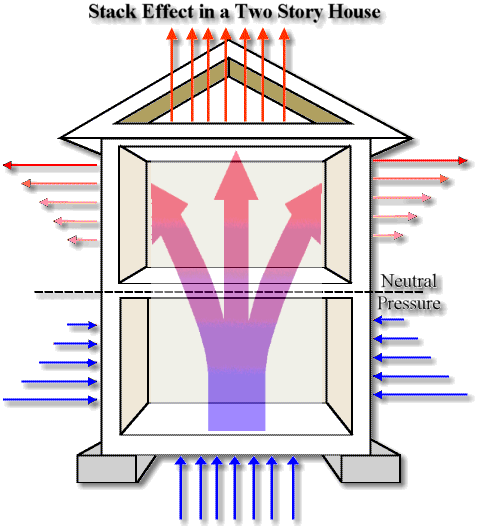

*The Stack Effect [click image to enlarge]

Science
Building Science
The Stack Effect
Since buildings are not totally sealed (at the very minimum, there is always a ground level entrance), the stack effect will cause air infiltration. During the heating season, the warmer indoor air rises up through the building and escapes at the top either through open windows, ventilation openings, or unintentional holes in ceilings, like ceiling fans and recessed lights. The rising warm air reduces the pressure in the base of the building, drawing cold air in through either open doors, windows, or other openings and leakage. During the cooling season, the stack effect is reversed, but is typically weaker due to lower temperature differences.
In a modern high-rise building with a well-sealed envelope, the stack effect can create significant pressure differences that must be given design consideration and may need to be addressed with mechanical ventilation. Stairwells, shafts, elevators, and the like, tend to contribute to the stack effect, while interior partitions, floors, and fire separations can mitigate it. Especially in case of fire, the stack effect needs to be controlled to prevent the spread of smoke and fire, and to maintain tenable conditions for occupants and firefighters.
The Stack Effect In Flue Gas Stacks & Chimneys:
The stack effect in industrial flue gas stacks is similar to that in buildings, except that it involves hot flue gases having large temperature differences with the ambient outside air. Furthermore, an industrial flue gas stack typically provides little obstruction for the flue gas along its length and is, in fact, normally optimized to enhance the stack effect to reduce fan energy requirements.
Large temperature differences between the outside air and the flue gases can create a strong stack effect in chimneys for buildings using a fireplace for heating. Fireplace chimneys can sometimes draw in more cold outside air than can be heated by the fireplace, resulting in a net heat loss.

